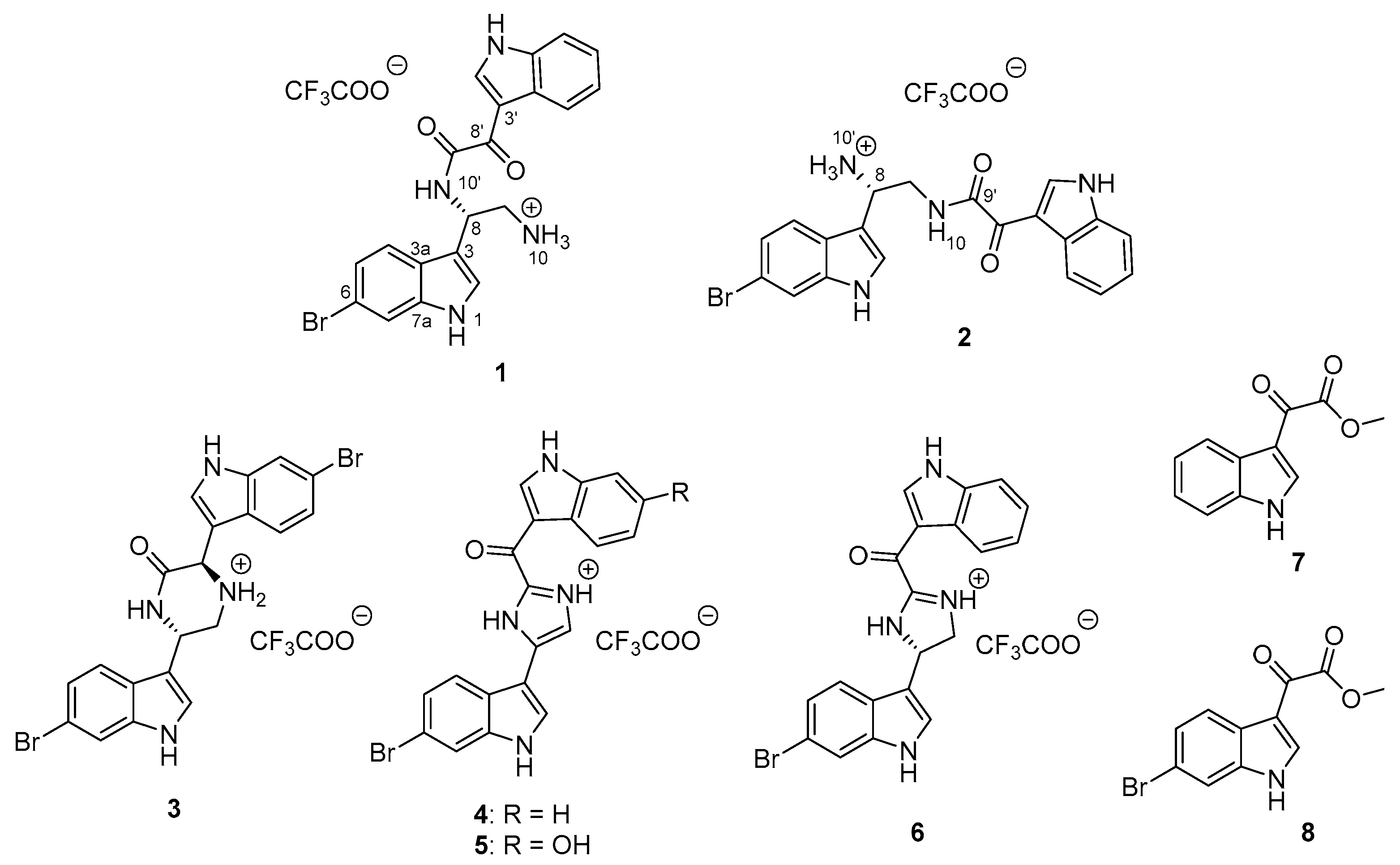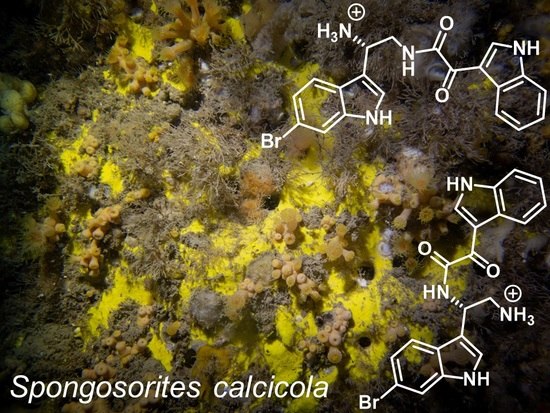Brominated Bisindole Alkaloids from the Celtic Sea Sponge Spongosorites calcicola
Abstract
1. Introduction
2. Results and Discussion
3. Materials and Methods
3.1. General Experimental Procedures
3.2. Biological Material
3.3. Extraction and Isolation
3.4. Computational Methods
3.5. Biological Screening
4. Conclusions
Supplementary Materials
Author Contributions
Funding
Acknowledgments
Conflicts of Interest
References
- Blunt, J.W.; Copp, B.R.; Hu, W.; Munro, M.H.G.; Northcote, P.T.; Prinsep, M.R. Marine natural products. Nat. Prod. Rep. 2008, 36, 35–94. [Google Scholar] [CrossRef] [PubMed]
- Carroll, A.R.; Copp, B.R.; Davis, R.A.; Keyzers, R.A.; Prinsep, M.R. Marine natural products. Nat. Prod. Rep. 2019, 36, 122–173. [Google Scholar] [CrossRef] [PubMed]
- Bao, B.; Zhang, P.; Lee, Y.; Hong, J.; Lee, C.; Jung, J.H. Monoindole Alkaloids from a Marine Sponge Spongosorites sp. Mar. Drugs 2007, 5, 31–39. [Google Scholar] [CrossRef] [PubMed]
- Bao, B.; Sun, Q.; Yao, X.; Hong, J.; Lee, C.; Sim, C.J.; Im, K.S.; Jung, J.H. Cytotoxic Bisindole Alkaloids from a Marine Sponge Spongosorites sp. J. Nat. Prod. 2005, 68, 711–715. [Google Scholar] [CrossRef] [PubMed]
- Bao, B.; Sun, Q.; Yao, X.; Hong., J.; Lee, C.; Cho, H.Y.; Jung, J.H. Bisindole Alkaloids of the Topsentin and Hamacanthin Classes from a Marine Sponge Spongosorites sp. J. Nat. Prod. 2007, 70, 2–8. [Google Scholar] [CrossRef] [PubMed]
- Bartik, K.; Braekman, J.; Daloze, D.; Stoller, C. Topsentins, new toxic bis-indole alkaloids from the marine sponge Topsentia genitrix. Can. J. Chem. 1987, 65, 2118–2121. [Google Scholar] [CrossRef]
- Wright, A.E.; Killday, K.B.; Chakrabarti, D.; Guzmán, E.A.; Harmody, D.; McCarthy, P.J.; Pitts, T.; Pomponi, S.A.; Reed, J.K.; Roberts, B.F.; et al. A Bioactive Bis-Indole Alkaloid from a Deep-Water Sponge of the Genus Spongosorites. Mar. Drugs 2017, 15, 16. [Google Scholar] [CrossRef] [PubMed]
- Gunasekera, S.P.; McCarthy, P.J.; Kelly-Borges, M. Hamacanthins A and B, new antifungal bis indole alkaloids from the deep-water marine sponge, Hamacantha sp. J. Nat. Prod. 1994, 57, 1437–1441. [Google Scholar] [CrossRef] [PubMed]
- Kohmoto, S.; Kashman, Y.; McConnell, O.J.; Rinehart, K.L.J.; Wright, A.; Koehn, F. Dragmacidin, a new cytotoxic bis(indole) alkaloid from a deep water marine sponge, Dragmacidon sp. J. Org. Chem. 1988, 53, 3116–3118. [Google Scholar] [CrossRef]
- Oh, K.; Mar, W.; Kim, S.; Kim, J.; Lee, T.; Kim, J.; Shin, D.; Sim, C.J.; Shin, J. Antimicrobial activity and cytotoxicity of bis (indole) alkaloids from the sponge Spongosorites sp. Biol. Pharm. Bull. 2006, 29, 570–573. [Google Scholar] [CrossRef] [PubMed]
- Oh, K.; Mar, W.; Kim, S.; Kim, J.; Kim, J.; Oh, M.; Kim, J.; Shin, D.; Sim, C.J.; Shin, J. Bis (indole) alkaloids as sortase A inhibitors from the sponge Spongosorites sp. Bioorg. Med. Chem. Lett. 2005, 15, 4927–4931. [Google Scholar] [CrossRef] [PubMed]
- Burres, N.S.; Barber, D.A.; Gunasekera, S.P.; Shen, L.L.; Clement, J. Antitumor activity and biochemical effects of topsentin. J. Biochem. Pharmacol. 1991, 42, 745–751. [Google Scholar] [CrossRef]
- Casapullo, A.; Bifulco, G.; Bruno, I.; Riccio, R. New Bisindole Alkaloids of the Topsentin and Hamacanthin Classes from the Mediterranean Marine Sponge Rhaphisia lacazei. J. Nat. Prod. 2000, 63, 447–451. [Google Scholar] [CrossRef] [PubMed]
- Tsujii, S.; Rinehart, K.L.; Gunasekera, S.P.; Kashman, Y.; Cross, S.S.; Lui, M.S.; Pomponi, S.A.; Diaz, M.C. Topsentin, bromotopsentin, and dihydrodeoxybromotopsentin: Antiviral and antitumor bis(indolyl)imidazoles from Caribbean deep-sea sponges of the family Halichondriidae. Structural and synthetic studies. J. Org. Chem. 1988, 53, 5446–5453. [Google Scholar] [CrossRef]
- Bokesch, H.R.; Pannell, L.K.; McKee, T.C.; Boyd, M.R. Coscinamides A, B and C, three new bis indole alkaloids from the marine sponge Coscinoderma sp. Tet. Lett. 2000, 41, 6305–6308. [Google Scholar] [CrossRef]
- Xiaofei, J.; Wang, Z.; Dong, J.; Liu, Y.; Lu, A.; Wang, Q. Discovery of topsentin alkaloids and their derivatives as novel antiviral and anti-phytopathogenic fungus agents. J. Agric. Food Chem. 2016, 64, 9143–9151. [Google Scholar]
- Willoughby, P.H.; Jansma, M.J.; Hoye, T.R. A guide to small-molecule structure assignment through computation of (1H and 13C) NMR chemical shifts. Nat. Protoc. 2014, 9, 643–660. [Google Scholar] [CrossRef] [PubMed]
- Frisch, M.J.; Trucks, G.W.; Schlegel, H.B.; Scuseria, G.E.; Robb, M.A.; Cheeseman, J.R.; Scalmani, G.; Barone, V.; Petersson, G.A.; Nakatsuji, H.; et al. Gaussian 16 Rev. B.01, Wallingford, CT, 2016. Available online: https://gaussian.com/g16new/ (accessed on 29 October 2019).
- Tomasi, J.; Mennucci, B.; Cammi, R. Quantum mechanical continuum solvation models. Chem. Rev. 2005, 105, 2999–3094. [Google Scholar] [CrossRef] [PubMed]
- Bruhn, T.; Schaumloeffel, A.; Hemberger, Y.; Bringmann, G. SpecDis: Quantifying the comparison of calculated and experimental electronic circular dichroism spectra. Chirality 2013, 25, 243–249. [Google Scholar] [CrossRef] [PubMed]
Sample Availability: Samples of the compounds 1–8 are stored in the chemical repository at the Marine Institute (Co. Galway) and are available from the authors. |



| Pos. | 1 | 2 | ||||
|---|---|---|---|---|---|---|
| δC, type | δH (J·in Hz) | HMBC | δC, type | δH (J·in·Hz) | HMBC | |
| 1 | 11.29, d (2.3) | 2, 3, 3a, 7a | 11.45, d (2.2) | 2, 3, 3a, 7a | ||
| 2 | 124.6, CH | 7.43, d (2.3) | 3, 3a, 7a | 125.3, CH | 7.58, d (2.6) | 3, 3a, 7a |
| 3 | 112.6, C | 109.6, C | ||||
| 3a | 124.5, C | 124.7, C | ||||
| 4 | 120.3, CH | 7.64, d (8.7) | 3, 6, 7a | 120.3, CH | 7.71, d (8.5) | 3, 6, 7a |
| 5 | 121.8, CH | 7.18, dd (8.7, 1.9) | 3a, 6, 7 | 122.2, CH | 7.23, dd (8.5, 1.7) | 3a, 6, 7 |
| 6 | 114.2, C | 114.5, C | ||||
| 7 | 114.3, CH | 7.58, d (1.9) | 3a, 5, 6 | 114.6, CH | 7.63, d (1.7) | 3a, 5, 6 |
| 7a | 137.0, C | 136.8, C | ||||
| 8 | 42.7, CH | 5.55, td (9.3, 4.6) | 2, 3, 3a, 9′ | 46.9, CH | 4.83, q (6.2) | 2, 3, 3a, 9 |
| 9 | 41.1, CH2 | 3.49, m 3.36, under H2O | 42.1, CH2 | 3.83, dt (13.8, 7.2) 3.70, dt (13.8, 5.7) | 3, 8, 9′ | |
| 10-NH | 7.98, br s | 8.95, t (6.1) | 9, 9′ | |||
| 1′ | 12.27, d (3.2) | 2′, 3′ | 12.26, d (3.0) | 2′, 3′,3′a,7′a | ||
| 2′ | 138.6, CH | 8.80, d (3.2) | 3′, 3′a, 7′a | 138.7, CH | 8.77, d (3.3) | 3′, 3′a, 7′a |
| 3′ | 112.1, C | 112.1, C | ||||
| 3′a | 126.3, C | 126.3, C | ||||
| 4′ | 121.2, CH | 8.22, dd (7.2, 2.1) | 6′, 7′a | 121.3, CH | 8.22, dd (6.8, 2.3) | 6′, 7′a |
| 5′ | 122.6, CH | 7.23, td (7.2, 2.0) | 3′a, 7′ | 122.7, CH | 7.25, td (6.9, 2.2) | 3′a, 7′ |
| 6′ | 123.5, CH | 7.25, td (7.2, 2.0) | 4′, 7′a | 123.6, CH | 7.27, td (6.9, 2.3) | 4′, 7′a |
| 7′ | 112.6, CH | 7.53, dd (7.2, 2.0) | 3′a, 5′ | 112.7, CH | 7.54, dd (7.0, 2.2) | 3′a, 5′ |
| 7′a | 136.2, C | 136.2, C | ||||
| 8′ | 181.2, C | 180.9, C | ||||
| 9′ | 163.1, C | 163.7, C | ||||
| 10′-NH | 9.15, d (9.2) | 8, 9′ | 8.33, br d (4.3) | 3 | ||
© 2019 by the authors. Licensee MDPI, Basel, Switzerland. This article is an open access article distributed under the terms and conditions of the Creative Commons Attribution (CC BY) license (http://creativecommons.org/licenses/by/4.0/).
Share and Cite
Jennings, L.K.; Khan, N.M.D.; Kaur, N.; Rodrigues, D.; Morrow, C.; Boyd, A.; Thomas, O.P. Brominated Bisindole Alkaloids from the Celtic Sea Sponge Spongosorites calcicola. Molecules 2019, 24, 3890. https://doi.org/10.3390/molecules24213890
Jennings LK, Khan NMD, Kaur N, Rodrigues D, Morrow C, Boyd A, Thomas OP. Brominated Bisindole Alkaloids from the Celtic Sea Sponge Spongosorites calcicola. Molecules. 2019; 24(21):3890. https://doi.org/10.3390/molecules24213890
Chicago/Turabian StyleJennings, Laurence K., Neyaz M. D. Khan, Navdeep Kaur, Daniel Rodrigues, Christine Morrow, Aoife Boyd, and Olivier P. Thomas. 2019. "Brominated Bisindole Alkaloids from the Celtic Sea Sponge Spongosorites calcicola" Molecules 24, no. 21: 3890. https://doi.org/10.3390/molecules24213890
APA StyleJennings, L. K., Khan, N. M. D., Kaur, N., Rodrigues, D., Morrow, C., Boyd, A., & Thomas, O. P. (2019). Brominated Bisindole Alkaloids from the Celtic Sea Sponge Spongosorites calcicola. Molecules, 24(21), 3890. https://doi.org/10.3390/molecules24213890








